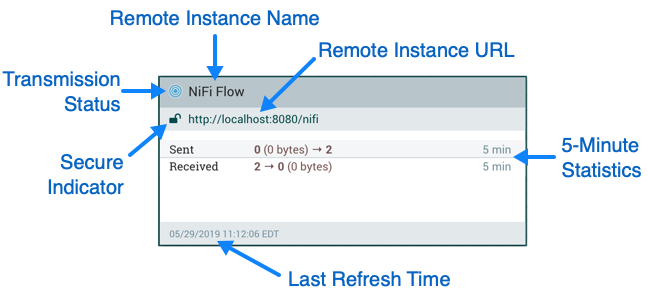Anatomy of a Remote Process Group
When creating a DataFlow, it is often necessary to transfer data from one instance of NiFi to another. In this case, the remote instance of NiFi can be thought of as a Process Group. For this reason, NiFi provides the concept of a Remote Process Group. From the User Interface, the Remote Process Group looks similar to the Process Group. However, rather than showing information about the inner workings and state of a Remote Process Group, such as queue sizes, the information rendered about a Remote Process Group is related to the interaction that occurs between this instance of NiFi and the remote instance.

The image above shows the different elements that make up a Remote Process Group. Here, we provide an explanation of the icons and details about the information provided.
-
Transmission Status: The Transmission Status indicates whether or not data Transmission between this instance of NiFi and the remote instance is currently enabled. The icon shown will be the Transmission Enabled icon (
 ) if any of the Input Ports or Output Ports is currently configured to transmit or the Transmission Disabled icon (
) if any of the Input Ports or Output Ports is currently configured to transmit or the Transmission Disabled icon (  ) if all of the Input Ports and Output Ports that are currently connected are stopped.
) if all of the Input Ports and Output Ports that are currently connected are stopped. -
Remote Instance Name: This is the name of the NiFi instance that was reported by the remote instance. When the Remote Process Group is first created, before this information has been obtained, the URL(s) of the remote instance will be shown here instead.
-
Remote Instance URL: This is the URL of the remote instance that the Remote Process Group points to. This URL is entered when the Remote Process Group is added to the canvas and it cannot be changed.
-
Secure Indicator: This icon indicates whether or not communications with the remote NiFi instance are secure. If communications with the remote instance are secure, this will be indicated by the "Locked" icon (
 ). If the communications are not secure, this will be indicated by the "Unlocked" icon (
). If the communications are not secure, this will be indicated by the "Unlocked" icon (  ). If the communications are secure, this instance of NiFi will not be able to communicate with the remote instance until an administrator for the remote instance grants access. Whenever the Remote Process Group is added to the canvas, this will automatically initiate a request to have a user for this instance of NiFi created on the remote instance. This instance will be unable to communicate with the remote instance until an administrator on the remote instance adds the user to the system and adds the "NiFi" role to the user. In the event that communications are not secure, the Remote Process Group is able to receive data from anyone, and the data is not encrypted while it is transferred between instances of NiFi.
). If the communications are secure, this instance of NiFi will not be able to communicate with the remote instance until an administrator for the remote instance grants access. Whenever the Remote Process Group is added to the canvas, this will automatically initiate a request to have a user for this instance of NiFi created on the remote instance. This instance will be unable to communicate with the remote instance until an administrator on the remote instance adds the user to the system and adds the "NiFi" role to the user. In the event that communications are not secure, the Remote Process Group is able to receive data from anyone, and the data is not encrypted while it is transferred between instances of NiFi. -
5-Minute Statistics: Two statistics are shown for Remote Process Groups: Sent and Received. Both of these are in the format <count> (<size>) where <count> is the number of FlowFiles that have been sent or received in the previous five minutes and <size> is the total size of those FlowFiles' content.
-
Last Refresh Time: The information that is pulled from a remote instance and rendered on the Remote Process Group in the User Interface is periodically refreshed in the background. This element indicates the time at which that refresh last happened, or if the information has not been refreshed for a significant amount of time, the value will change to indicate Remote flow not current. NiFi can be triggered to initiate a refresh of this information by right-clicking on the Remote Process Group and choosing the "Refresh remote" menu item.

